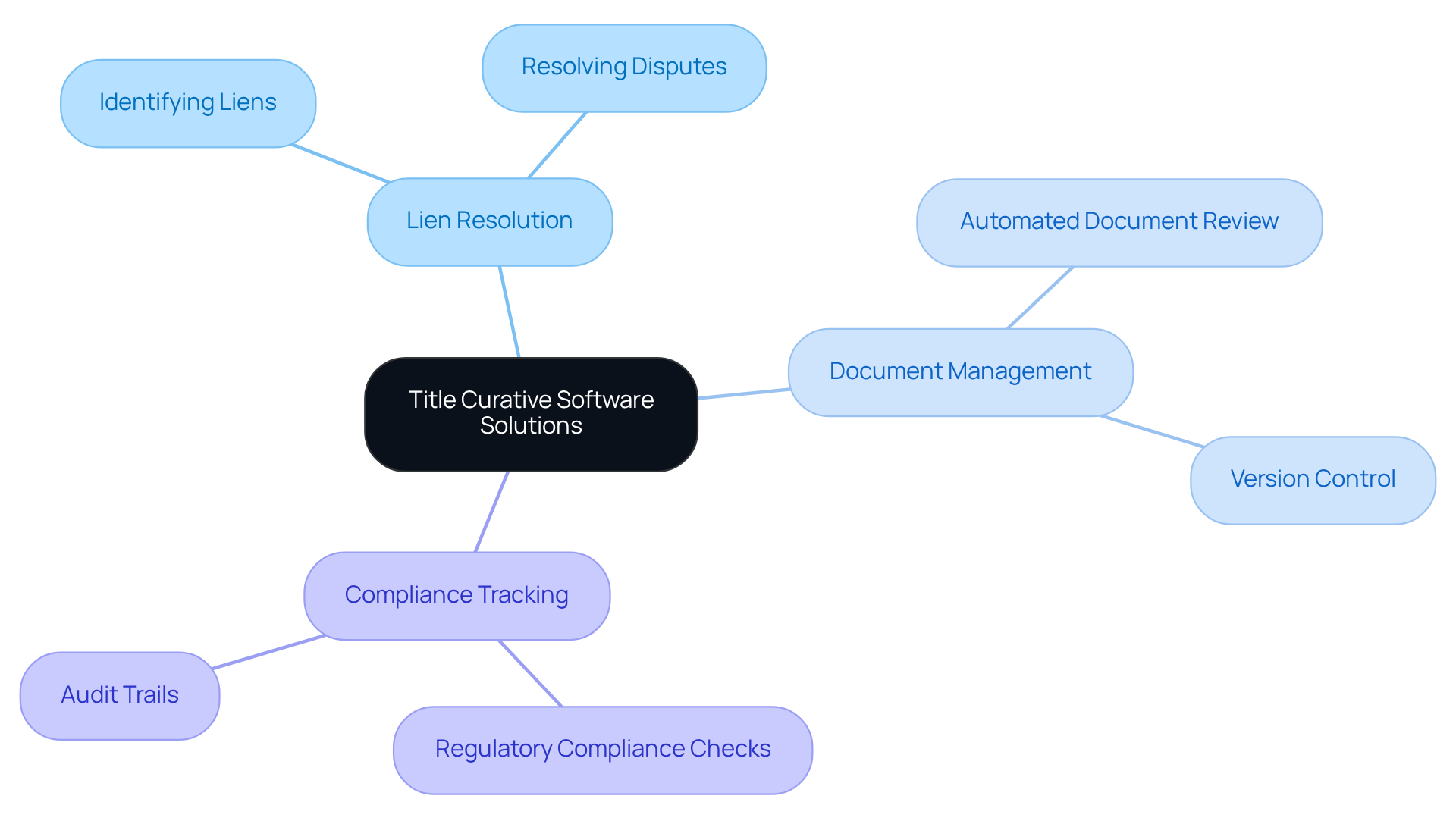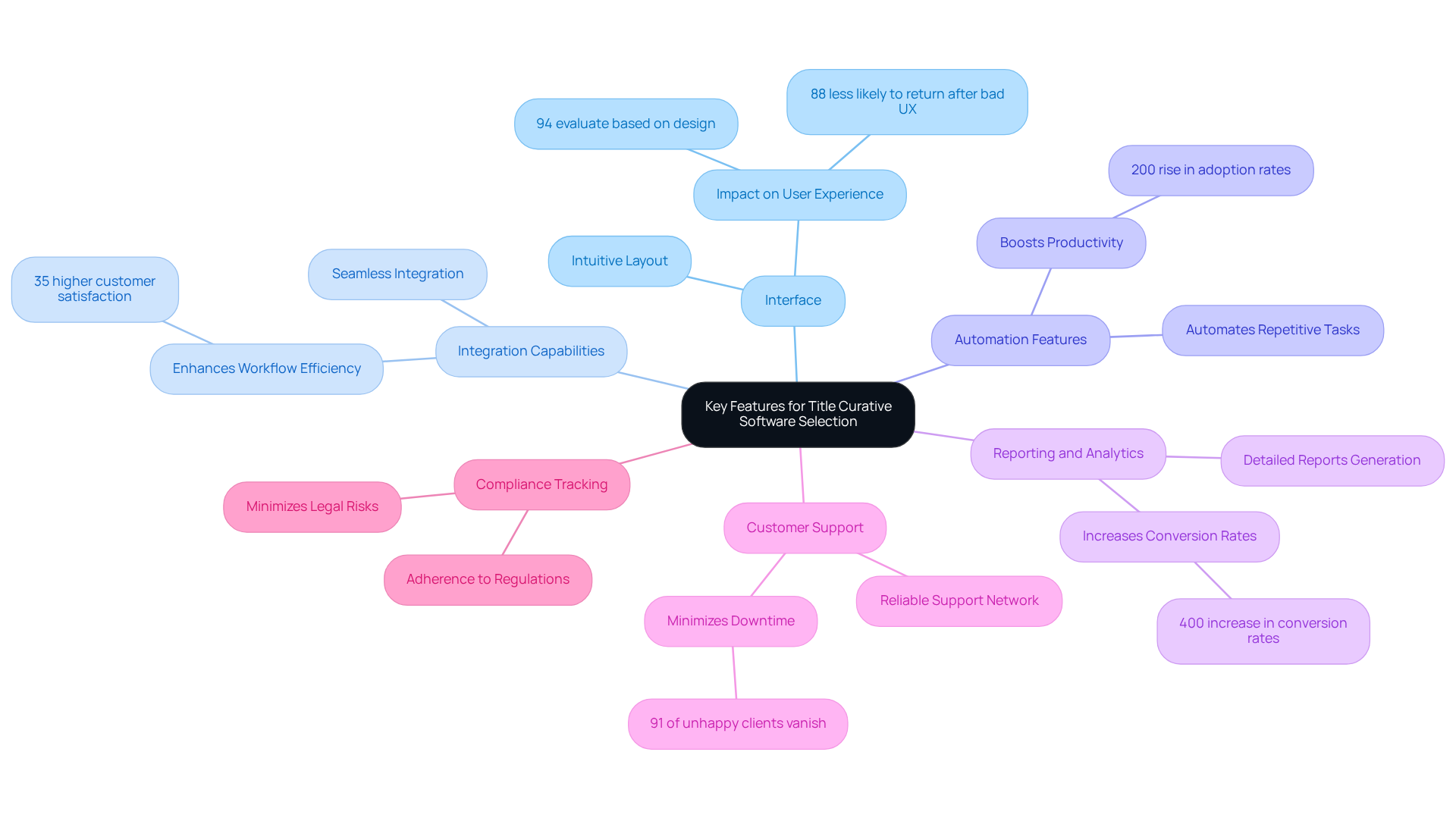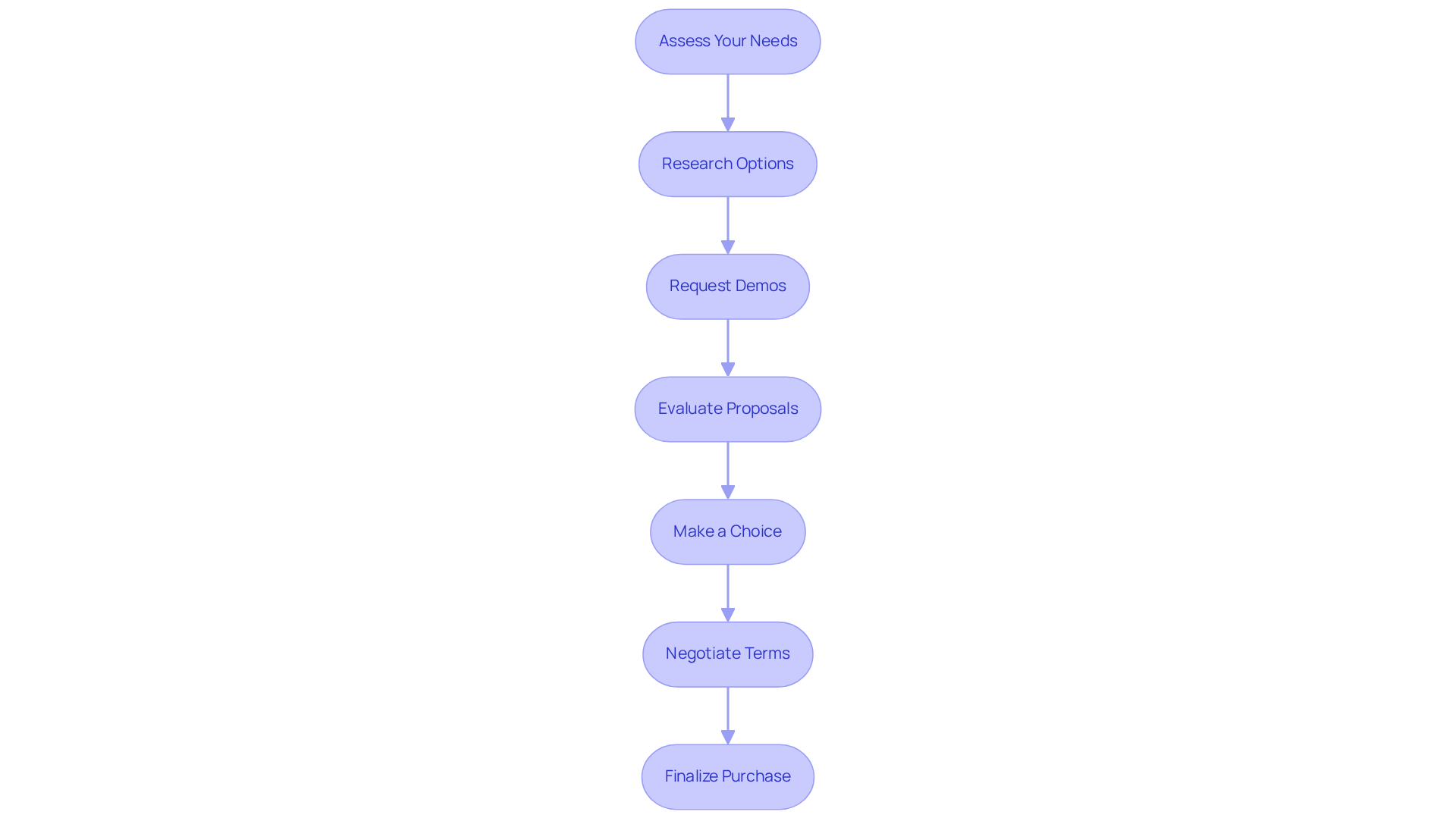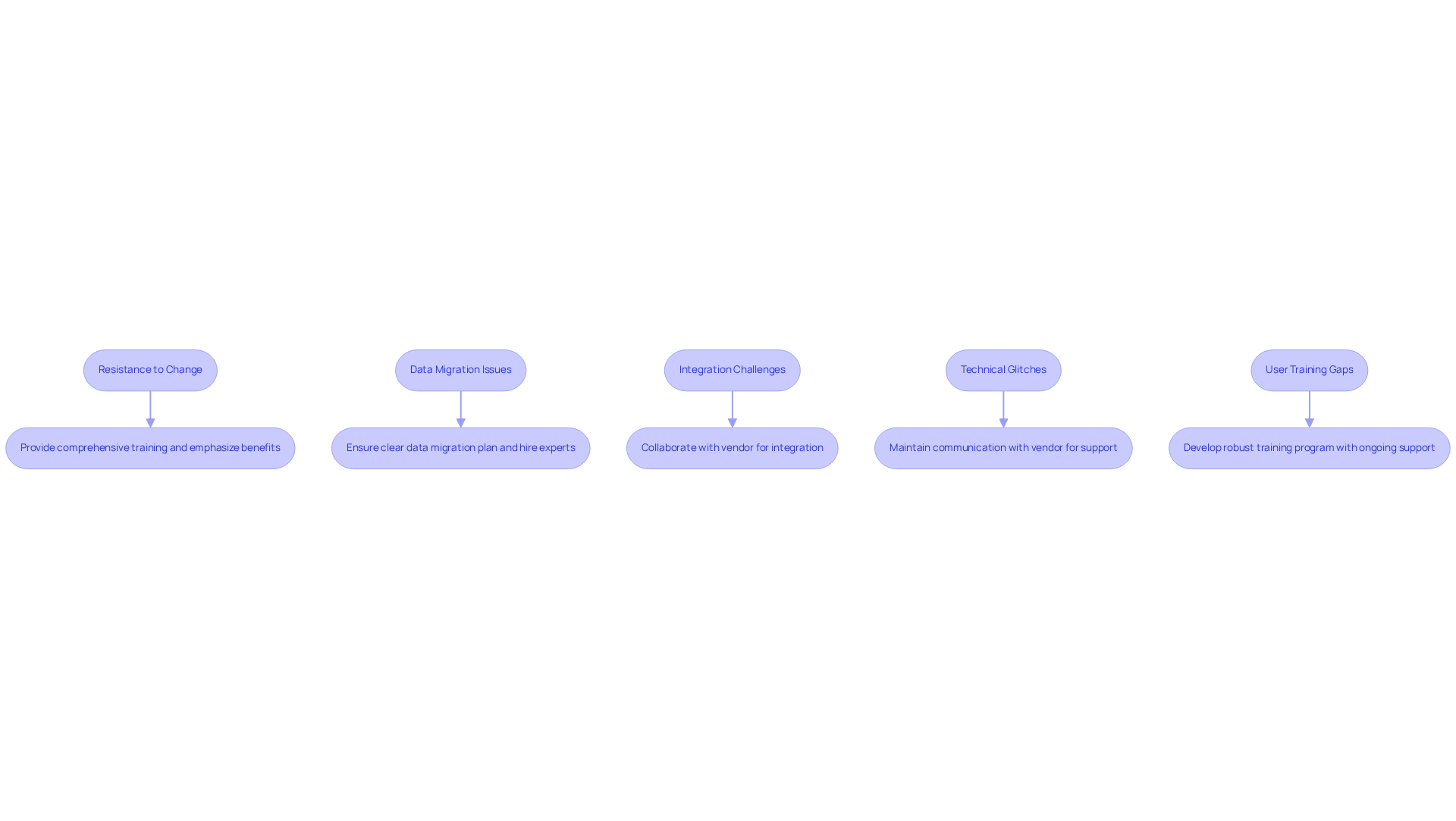Overview
To effectively acquire a title curative software solution, it is essential to adhere to a structured purchasing process. This process encompasses:
- Assessing needs
- Researching options
- Requesting demos
- Evaluating proposals
A comprehensive understanding of key features is crucial, including:
- Automation
- Integration capabilities
- Customer support
Such knowledge is vital for selecting software that not only enhances efficiency but also meets specific operational requirements in real estate transactions. Consequently, following this structured approach ensures that the chosen solution aligns with the unique demands of the industry.
Introduction
Navigating the complexities of real estate transactions hinges on the accuracy of property documentation, rendering title curative software solutions indispensable. These advanced tools streamline the identification and rectification of document flaws while significantly enhancing operational efficiency through automation and integration.
However, with myriad options available, how can professionals ensure they select the right software to meet their unique needs? By exploring essential steps and criteria for purchasing title curative software, real estate experts are empowered, mitigating potential challenges in implementation, leading to smoother transactions and improved client satisfaction.
Understand Title Curative Software Solutions
It is essential to buy systems as they are pivotal in identifying and rectifying flaws in property documents, which can impede . By leveraging advanced technologies such as , these solutions significantly enhance the efficiency of document examination and correction processes. Furthermore, by , they empower to conserve valuable time and minimize errors.
Key functionalities of these tools encompass:
All of which are essential when you decide to buy title curative software solution tailored to your specific needs. The impact of these innovations is profound, as they not only but also promote more accurate and timely document resolutions, ultimately facilitating .

Identify Key Features and Criteria for Selection
When selecting , it is crucial to consider the following key features and criteria:
- Interface: An intuitive layout is essential for allowing individuals to navigate effortlessly and execute tasks efficiently. Studies show that 94% of individuals evaluate a website according to its design, and 88% of customers are less inclined to revisit a site following a negative experience. This highlights the significance of a well-designed experience in technology adoption.
- Integration Capabilities: The application must integrate seamlessly with existing systems, such as document management and . and data accuracy, making this a critical feature. Organizations with a strong commitment to UX design experience 35% higher customer satisfaction, underscoring the positive impact of seamless integrations on user satisfaction and workflow efficiency.
- Automation Features: Look for software that automates repetitive tasks, such as document retrieval and lien resolution. Automation not only boosts productivity but also reduces the likelihood of human error, which is essential in title research. , emphasizing the significance of automation in improving productivity.
- Reporting and Analytics: The ability to generate is crucial for tracking performance and identifying areas for improvement. Effective reporting tools can lead to a 400% increase in conversion rates, demonstrating their value in decision-making processes. Additionally, , further illustrating the financial benefits of robust reporting and analytics features.
- Customer Support: is essential for troubleshooting and ensuring smooth operation during implementation and beyond. A robust support network can greatly minimize downtime and improve client satisfaction. Notably, 91% of dissatisfied clients who don’t voice their concerns simply vanish without input, highlighting the essential role of customer support in client retention.
- Compliance Tracking: The application should aid in upholding adherence to local and federal regulations, thereby minimizing the risk of legal issues. This feature is particularly important in the real estate sector, where regulatory adherence is paramount. Including relevant data on compliance tracking would strengthen this point and demonstrate its significance in the real estate sector.
By concentrating on these criteria, real estate experts can decide to buy title curative software solution that not only addresses their operational requirements but also improves overall efficiency and user satisfaction.

Follow a Step-by-Step Purchasing Process
To effectively purchase , adhere to the following steps:
- : Begin by evaluating your organization's specific requirements, including the volume of transactions, types of title issues commonly encountered, and desired features. Grasping these factors is essential for choosing a system that aligns with your operational objectives.
- Research Options: , comparing features, pricing, and user reviews. Utilize resources such as industry blogs and application review sites to gather insights. With numerous options available, a comprehensive comparison will help identify the best fit for your needs.
- Request Demos: Contact product vendors to . This will enable you to observe the application in action and inquire about its functionalities. Interacting with vendors during this phase can offer valuable insights into how their offerings can tackle your specific challenges.
- Evaluate Proposals: After demos, , , support, and scalability. Make a shortlist of the most suitable options. Pay attention to the total cost of ownership, which includes both initial and ongoing expenses, to ensure a well-informed decision.
- Make a Choice: Based on your evaluations, and budget. with the decision to buy for a smooth implementation process.
- Negotiate Terms: Before finalizing the purchase, , including pricing, support, and any additional services. Clear communication during this stage can help establish a strong partnership moving forward.
- Finalize Purchase: Complete the purchase and ensure that all necessary documentation is in order. This encompasses verifying licensing agreements and comprehending the terms of use, which can differ greatly among various applications.

Troubleshoot Common Implementation Challenges
Implementing a may present several challenges. Understanding these challenges is crucial for the of the buy title curative software solution, as they can significantly impact overall effectiveness. Here are common issues and strategies to troubleshoot them:
- : Employees may be reluctant to embrace new technology due to fear of the unknown or familiarity with current systems. To address this, provide on how to buy title curative software solution and emphasize the benefits of the new system. Fostering a culture of open communication and involvement in the decision-making process encourages buy-in. Research shows that organizations that clearly communicate desired outcomes see a 3.5-fold increase in success rates.
- Issues: Transferring data from legacy systems can be fraught with complications. Studies indicate that only 36% of data migration projects stay within budget and 46% are completed on time. Therefore, ensure you have a clear data migration plan, and consider hiring experts to facilitate the process, mitigating risks associated with data ownership and logistical challenges.
- : If the new application does not integrate seamlessly with existing systems, it can lead to inefficiencies. Collaborate closely with the vendor to buy title curative software solution that will help resolve integration issues and ensure compatibility. often hinge on effective communication and alignment between IT and business units. Companies are three times more likely to succeed in digital transformation when using piloting and prototyping processes.
- Technical Glitches: Software bugs can disrupt operations and lead to annoyance among individuals. Maintain open lines of communication with the vendor for prompt support and updates, ensuring that any are resolved quickly to minimize downtime. Establishing continuous feedback mechanisms is crucial for addressing technical challenges effectively.
- : Insufficient training can lead to underutilization of the program. Develop a robust training program that includes hands-on sessions and ongoing support. Ensuring all users are proficient and confident in using the new system is essential. Engaging employees in the training process can significantly enhance their commitment to adopting the new software. Organizations that track KPIs during change implementation achieve a 51% success rate.

Conclusion
Investing in a title curative software solution is a strategic move that can revolutionize the efficiency and accuracy of real estate transactions. By automating labor-intensive processes and enhancing document examination, these systems not only save time but also significantly reduce errors. Understanding the core functionalities—such as lien resolution, document management, and compliance tracking—is crucial for selecting the right software tailored to specific operational needs.
The process of purchasing title curative software involves several key steps:
- Assessing organizational needs
- Researching options
- Requesting demos
- Evaluating proposals
Each of these steps is designed to ensure that the chosen software aligns with both the budget and the operational goals of the organization. Furthermore, addressing potential implementation challenges—such as resistance to change, data migration issues, and integration difficulties—can lead to a smoother transition and greater user satisfaction.
Ultimately, the right title curative software can transform the way real estate professionals manage their workflows, leading to improved compliance, enhanced productivity, and streamlined transactions. Embracing these advanced technologies not only facilitates smoother real estate dealings but also positions organizations for future success in a competitive market. Taking the time to carefully evaluate options and prepare for implementation can yield significant long-term benefits, making the investment in title curative software a wise choice for any real estate professional.
Frequently Asked Questions
What is the purpose of title curative software solutions?
Title curative software solutions are designed to identify and rectify flaws in property documents that can impede real estate transactions.
How do title curative software solutions enhance efficiency?
They leverage advanced technologies such as machine learning and optical character recognition to improve the efficiency of document examination and correction processes.
What are the key functionalities of title curative software solutions?
Key functionalities include lien resolution, document management, and compliance tracking.
How do these software solutions benefit property researchers and real estate professionals?
By automating traditionally labor-intensive tasks, they help conserve valuable time and minimize errors in the document handling process.
What is the overall impact of title curative software solutions on real estate transactions?
These solutions streamline workflows, promote more accurate and timely document resolutions, and facilitate smoother real estate transactions.




